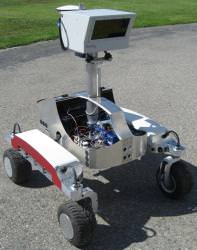The question of whether humans or robots should explore space has been decided by NASA: it’ll be both. In the future, NASA anticipates that humans will work with robotic explorers to gather and analyze data more efficiently than either could do alone. This will be the eventual scenario when humans set foot on the Moon again, as part of the Vision for Space Exploration.
Two prototype Moon rovers are currently crawling around a polar desert in the Arctic Circle, helping scientists develop the skills and experience they’ll need to do this for real on other worlds. The robots are named K10 Black and K10 Red, and carry 3-D laser scanners and ground-penetrating radar.
They arrived at the Haughton Crater on Devon Island, Canada on July 12, and will continue their operations until July 31. The robots are using different techniques to study the interior of the 20 km (12.4 mile) crater. For example, their 3-D laser scanner can map topographic features as much as a kilometre away, and the ground penetrating radar can peer down 5 metres. The robots are just covering the terrain like lawn mowers, mapping it out strip by strip.
Over the course of the study, the rovers will cover an area of approximately 120 acres of terrain, operated completely remotely from the Haughton-Mars base camp located several kilometres away.
Original Source: NASA News Release

